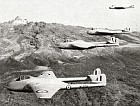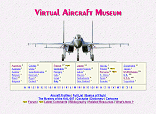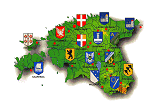Aircraft Profile #48. De Havilland Vampire |
|
|
Fondly referred to by many post-war pilots as the "aerial kiddy car", the Vampire day fighter was certainly the last unsophisticated single-engine frontline aircraft to serve with Britain's Fighter Command. To qualify this distinction, one must first point out that all its flying controls were manually-operated without recourse to or necessity for power assistance. No radar was fitted and the fighter consisted of a simple airframe, ''first generation" jet engine, and four 20-mm Hispano guns aimed by a gyro gunsight. Only the twin boom layout set the Vampire aside as being unconventional among its contemporaries. Detail design of the de Havilland D.H. 100 Vampire commenced early in 1942 after acceptance of proposals submitted to Air Ministry Specification E.6/41. Though this called for an experimental prototype, provision for gun armament was included in the design from the earliest days, the newly-established four 20-mm Hispano gun battery being housed in the underside of the fuselage nacelle. Power was supplied by one D.H. Goblin I jet engine which employed a single-sided centrifugal compressor and produced 1225kg thrust. Construction was composite metal and balsa/ply, the fuselage nacelle continuing the wood application used in the successful Mosquito design which
Vampire Is were also supplied in various versions to Canada, Switzerland and Sweden, and thence by various routes to Austria and the Dominican Republic. Vampire II was the designation applied to three experimental Nene-powered Vampires, TG276, TG280 and TX807, identified by dorsal intakes demanded by the double-sided compressor of the
The Vampire III represented an attempt to increase the effectiveness of the design in the environment of increased radar warning range, anticipated shortly after the end of the war. The first-generation jet fighter was widely characterised by a chronic lack of range, in the case of the Vampire I only about 700 statute miles. The early Vampires had used Mosquito-type underwing slipper tanks, but the Mark III introduced wing tankage and provision for 100- or 200-gallon drop tanks. Developed to Spec. F.3/47, the Vampire 3 (so designated after the change to arable numerals) entered R.A.F. service late in 1947 and remained with the R. Aux, A.F. until well into the nineteen-fiftics. The type was also characterised by alterations to the tail unit: the tailplane was lowered and the vertical surfaces were changed to conform more nearly to the well-known de Havilland outline. The Vampire 3 made history when six aircraft of No. 54 (Fighter) Squadron became the first British jet aircraft to cross the Atlantic, refuelling in Iceland,
Re-design of the Vampire wing to accommodate pylon-mounted drop tanks inevitably led to the carriage of other stores and hence adaptation of the design for ground-attack duties. With low-level performance of prime importance, the wing span was reduced by 0.6m so that the wing tips were square cut (trials with this wing were carried out on Vampire I, TG444), and the provision of strongpoints for bombs and rockets was accompanied by greater strength factors and thicker wing skinning. The increased wing loading in turn resulted in greater sinking speeds on landing and this demanded undercarriage legs of increased travel. Thus was evolved the Vampire F.B.Mark 5. THE VAMPIRE 5 The first production Vampire F.B.5 flew on 23rd June 1948 and by the end of the year was replacing Vampire 3s in Fighter Command. Next they started to replace Mosquitos in R.A.F. Squadrons in Germany and later joined Mark 3s in service with the R. Aux. A.F. It was however in Germany that the Vampire served in the largest numbers for, with the increased tension following the Berlin Airlift and with a war being fought
At home, Vampires served in Nos. 11 and 12 Groups in the south of England with Nos. 54 and 247 (Fighter) Squadrons at Odiham, and also Nos. 72 and 130 Squadrons. With the Auxiliaries, they served on Nos. 501, 502, 601, 602, 603, 604, 605, 607, 608, 609, 612, 613 and 614, and were still serving on these Squadrons when the R. Aux. A.F. was disbanded in 1957. The Vampire 5 also served in the Middle and Far East, and it was in the latter area that their weapons were discharged in anger. No. 32 (Fighter) Squadron had operated Vampire 3s from Nicosia since 1949, and carried out tropical trials with the type; in January 1951 the Squadron moved to Shallufa and converted to Mark 5s. The month previously No. 60 Squadron, based at Tengah, Singapore, took delivery of Vampire 5s and very soon the new aircraft were in
By 1953 the Vampire was becoming outdated in the Regular Air Force at home. (At the same time the Meteor 8 only managed to remain relatively effective by the addition of spring tabs and other minor improvements.) On being replaced by Meteor 8s, Vampire 5s were relegated to Flying Training Command, serving with Advanced Flying Schools Operational Conversion Units and the School of Air Armament. THE VAMPIRE 9 Experience with Vampire 3s and 5s in tropical climates during 1949-51 illustrated the need to provide the pilots with refrigeration equipment. The result was the inclusion of a Godfrey refrigerator unit in the starboard wing intake fillet, resulting in the fillet being extended about eight inches forward. At the same time it had also been demonstrated that the performance of jet aircraft suffered in the high ambient temperatures of the tropics, and experience with Vampires exported to tropical countries had engendered the development of the uprated Goblin 3 which, with dual fuel booster pumps, developed 1590kg thrust. This engine was also adopted in the Vampire F.B.Mk.9. The first Vampire 9s to go
Shortly afterwards Vampire 9s equipped the Middle East Squadrons, Nos. 6, 8, 32, 73, 213 and 249 based at Nicosia, Shallufa, Habbaniyah, Khormaksar and in the Suez Canal Zone. Aircraft of No. 8 Squadron, based in Kenya, took part in the prolonged policing operations against the Mau Mau terrorists. With the introduction of the Venom F.B.I during 1954 and 1955, the Vampire 9s were brought home and joined earlier versions on training units. In its day the Vampire was an excellent transitional training aircraft. In service with Operational Conversion Units at Valley in Anglesey, and Chivenor, North Devon, they were used to "convert" pilots from the North American Harvard to operational fighters such as the Gloster Meteor 8 and North American Sabre. They were also used to convert night fighter pilots from Mosquitos to the Vampire 10. Among jet fighters, they were forgiving aeroplanes. During an air gunnery sortie from Chivenor a pilot returned to base with the target flag wedged in his starboard air
THE VAMPIRE AT SEA Ever since Lt.-Cdr. E.
When the Air Ministry issued a specification covering the Vampire 5 with increased range in 1947, the Admiralty ordered 18 examples with which to introduce jet operating techniques to operational pilots and deck crews. Honours for the first British jet fighter to reach operational status however fell to the Supermarine Attacker. First of the naval Vampires to fly - designated Sea Vampire F.20 - was VVJ36, on 15th
The Sea Vampire was distinguishable from the R.A.F. version in being equipped with a Vee-frame arrester hook installed over the engine jet pipe, so that when lowering it passed through the jet flow. Air brakes and landing flaps were enlarged to give better low speed control for the approach to the deck, and load factors were increased to cater for greater deck landing loads. A development was the Sea Vampire F.21, of which three examples were produced, and this was used both at the Royal Aircraft Establishment, Farnborough, and on H.M.S. Warrior for undercarriage-less landings. With strengthened undersides the aircraft were flown on to rubberised deck surfaces with wheels retracted, the purpose being principally to accelerate deck handling simply by bodily manhandling the fighter out of the path of following aircraft. VAMPIRES FOR EXPORT Though not strictly akin to the Vampire 5,
The principal export variant was the Vampire 6, powered by the Goblin 3. One hundred Mark 6s were licence built in Switzerland by a consortium comprising the Federal Aircraft Plant at Emmen, Pilatus and Flug und Fahrzeugwerke A.G. Sweden ordered the Vampire F.B.50 based on the Mk. 5, while the Goblin 3-powered F.B.52 was sold to Finland, Norway, Egypt, Iraq, Lebanon and Venezuela, twelve standard Mark 5s were diverted to the Indian Air Force and 27 went to the South African Air Force. Overseas licence production included 80 F.B. Mk. 52As produced by Macchi and Fiat in Italy, and 67 standard Mark 5s assembled in France by S.N.C.A. du Sud-Est. At the time of writing some Vampires are still airworthy in Venezuela, Finland and the Lebanon. FLYING THE VAMPIRE Undoubtedly the outstanding feature of the Vampire's handling characteristics was its incredible
Take-off. So simple were the Vampire's systems that only six take-off Vital Actions were necessary: trim neutral, high and low pressure fuel cocks "on", booster pump "on", flaps selected as required and air brakes "in". When flown clean, acceleration on takeoff was sprightly and the aircraft could be lifted from the runway at about 110 knots. When carrying drop tanks or bombs it was necessary to retract the wheels quickly otherwise the airflow between the stores and wheel fairings would build up and cause the doors to stay open. As no nosewheel brake was included, the still-rotating nosewheel entering its recess immediately below the pilot often caused so much noise and vibration that the uninitiated momentarily anticipated instant catastrophe. In the air. Engine handling took some getting used to. Pilots experienced in piston
Due to the relatively good power/weight ratio of the single-seat Vampire, the aeroplane was tremendously manoeuvrable within the 600-800km/h speed range. At lower speeds, however, steep turns required coarse use of rudder to maintain height, and it was uncomfortably simple to stall in relatively shallow turns. The stall was likely to be accompanied by quite sharp wing-drop, but a surprising amount of aileron control existed right down to the stall, albeit with marked control buffet. One was advised to recover quickly while use of the most effective elevator could be maintained. Though by no means dangerous, the spin could be embarrassing owing to blanking of the diminutive rudders and the necessity to use coarse elevator control resulted in the aircraft pointing at terra firma for an uncomfortable length of time while speed built up! Aerobatics in the Vampire were sheer joy and were strangely akin to those of light sporting aircraft, apart, of course, from the airspeed
At the upper end of the speed range, the Vampire behaved in singular fashion with the onset of compressibility, and from M=0.71 up to 0.76 the aircraft displayed increasing porpoising and wing buffet until at M0.79 the aircraft would suddenly "break" up or down with the likelihood of a wing drop, giving the sensation of an "incipient" flick roll. Recovery from high Mach runs was simple with use of the air brakes, though below 450km/h these were of little real value. Should a flame-out occur in flight, a forced landing was unavoidable as no re-light system was provided. Ditching was not recommended and, if over water, the pilot was advised to vacate his cockpit. Landing. Landing vital actions, like those for take-off, were minimal: wheel brakes checked off, landing gear indicated down (three green lights), flaps fully down on final approach, and air brakes in. After turning on to the final approach at about 195km/h, speed was reduced so as to cross the runway threshold
The cockpit. By later standards, the cockpit was distinctly untidy. The fuel gauges were virtually invisible without moving the control column back! And then some mental arithmetic was required to tot up the fuel remaining in the various tanks. Although not required in flight (except in the event of a forced landing), movement of the low pressure fuel cock demanded double-jointed fingers as the lever was carefully concealed behind the throttle! Despite these shortcomings, view from the cockpit was superlative, and this together with the small size of the Vampire contributed to a feeling of being an integral part of a delightfully sensitive flying machine. (C) Francis K. Mason, 1965 |
 All the World's Rotorcraft
|















